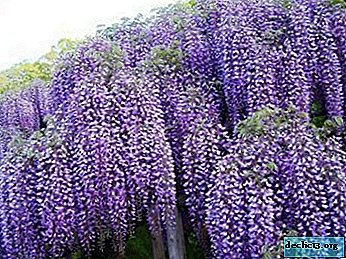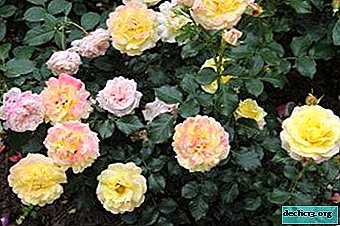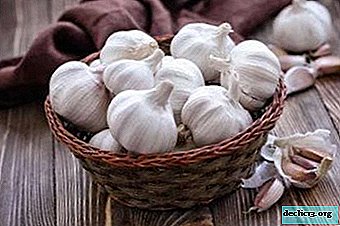Chinese decorative wisteria - a wonderful decoration for the garden and home
 Remember the series “Desperate Housewives”? All the action took place on the street Wisteria Lane.
Remember the series “Desperate Housewives”? All the action took place on the street Wisteria Lane.
The street got its name thanks to the flowers that grew everywhere and served as the same decoration for the dramatic events of the series as the houses of the main characters.
What is this wisteria? This is Wisteria Chinese lush flowering, ornamental plant. It can be a wonderful decoration for the gazebo or the wall of the house. Wisteria leaves no one indifferent, who at least once saw its flowering and felt a delicate, sweet aroma of flowers.
General information
Wisteria Wisteria (lat.) Or Chinese Wisteria is a lian from the legume family. A plant with a tree-like, counterclockwise twisted stem. In an adult creeper, the trunk diameter can reach 25 cm. A plant with dense, large foliage of complex shape. Leaves are pinnate, composed of several leaves and grow up to 30 cm in size. Usually, by the time of flowering, the leaves still do not have time to open.
Wisteria is a subtropical plant that the sun loves. It is common in nature in the warm climate of Asian countries, for example, it is found everywhere in China. However, there are varieties that are successfully grown in the middle climate zone.
The species was first described by the botanist Tamas Nuttal. He named Wisteria after the physician Caspar Wister. Hence the Latin name Wisteria (Wisteria).Basic views and photos
Violet (Wisteria chinensis)

A tree-like liana hails from China and grows up to 20m high. The leaves are large, pinnate, with delicate pubescence in youth. Very spectacular and beautiful during the flowering period of the vine. Light purple flowers collected in brushes up to 30 cm long. Blooms in the spring and preserves separately blooming inflorescences throughout the summer.
Liana grows in fertile well-moistened soils, very photophilous.It grows quickly, it is characterized by frost resistance - it tolerates short-term temperature drops well. During a harsh winter, it requires good shelter. Perfectly takes root at home, so it is often used in vertical landscaping. Preserves decorative properties in the fall, when elegant cirrus foliage turns golden yellow. They also grow a standard form, tree-like, erect, which is achieved by regular pruning.
Prolific (Wisteria sinensis Prolific)

A tree-like liana with a barrel twisted to the right, grows up to 6 m long. The leaves are large, pinnate, bright green in the summer and golden yellow in the fall. Flowering begins in May and may repeat in August. The flowers are bluish-violet, collected in large, racemose, up to 30 cm, inflorescences. After planting, it begins to bloom for 2-3 years. Liana prefers moderately fertile soils of medium humidity. Wisteria Prolifeh is sunlit.
It grows well and blooms profusely in warm, sheltered from the wind, sunny places. It grows well in the middle lane, but it can freeze during a harsh winter. Perfect for decorating gazebos, walls of buildings or hedges.
Blue Sapphire (Wisteria Blue Sapphire)

Most often used by gardeners to decorate hedges, arbors and walls. The tree trunk grows to 6 m and twists clockwise around the support. The bluish-purple flowers bloom in May and bloom until July, giving off a sugary sweet aroma. With plenty of sunshine, it is possible to bloom again in August.
In more detail about the wisteria Blue Sapphire we wrote in this article.
Alba (Wisteria Alba)

This wisteria variety is characterized by long flowering from May to autumn.. The tree trunk is up to 10-15 m high. Lush brushes of snow-white flowers grow up to 30 cm. In landscape design, it is used to decorate buildings, arbors and pergolas. You can also decorate the pool or pond with this vine.
More information about Wisteria Alba can be found here.
Wisteria sinensis

Liana Wisteria sinensis is very thermophilic, therefore it is mainly distributed in the southern latitudes. The plant is densely leafy with bluish flowers collected in large inflorescences. The flowers have a bluish color and a delicate aroma.
Macrostachia (Wisteria macrostachya)

Frost-resistant grade of wisteria. It tolerates winter and frost to -40 degrees. If there is no snow, it may freeze, in such cases shelter is required. However, due to sleeping kidneys it is quickly restored. It blooms profusely from early June and blooms less intensely until autumn. Large, lavender-blue flowers are collected in lush clusters up to 30 cm long. The height of the vine is 6-7 meters. Suitable for decorating hedges, pergolas, walls and gazebos.
Care and reproduction
- Wisteria requires careful care. Vine seedlings are difficult to take root and do not bloom for a long time. The first flowers can only be seen in five years, and those grown from seeds bloom in eight years.
- You also need to remember that this is a liana, which means it requires good support. For a growing plant, a frame made of wood, steel or thick reinforcement is suitable. During flowering, it becomes several times heavier, so the support must be reliable and well fixed.Strongly overgrown plants can break due to their own gravity, so timely pruning is necessary.
- Wisteria is a sun-loving plant. The ideal place to land is the sunny, calm side of the house or gazebo. Also canopies, pergolas and hedges for planting vines should be installed in sunny areas.
- Wisteria should be fertilized weekly before flowering. If the plant has not been color for several years, then in autumn it is necessary to add potash bait. Watering the vine should be constant, but moderate.
There are four ways to grow wisteria:
- from seeds;
- seedlings;
- layering;
- cuttings.
The first two are the simplest. It is enough to germinate the seeds, to grow seedlings from the sprouted and with proper care to wait for the result.
For propagation by layering:
- It is necessary to choose a one-year shoot, slant obliquely in the middle and place in a clay-turf substrate.
- Next, the shoot is dug in such a way that only the tip remains. Next year it will separate from the main plant.
Cuttings are carried out in the spring before the flowering period:
- Annual shoots are cut into cuttings 25 cm long and rooted in a specially prepared substrate.
- For the substrate, one part of humus, peat, sand and three parts of sod soil are taken.
You will find more information about growing wisteria at home and in the garden, as well as about caring for this plant in a separate material.
Cognitive video about the care and propagation of creepers:
Bloom
 Wisteria blooms from May to Junehowever, if enough heat and sun can bloom in September. There are a lot of flowers, they are collected in large inflorescences, which reach 30 cm in length.
Wisteria blooms from May to Junehowever, if enough heat and sun can bloom in September. There are a lot of flowers, they are collected in large inflorescences, which reach 30 cm in length.
Lush brushes cascade down and exude a delicate aroma. In the middle of summer, a fruit is tied - a bean with a velvety, thick pubescence.
Wisteria is prized primarily for lush flowering. To keep it going as long as possible, you should follow a few rules:
- Watering. During flowering, the vine should be often but moderately watered.
- Top dressing. Be sure to fertilize from early spring to flowering. You can make a little dressing during the flowering period.
- Pruning. The plant needs competent pruning. Liana may not bloom for many years without proper pruning. Pruning should become regular when the plant reaches the age of two years. Spend her in the middle of summer. Young growths of 3-4 kidneys are cut off. Such pruning stimulates abundant flowering plants.
Watch the video how beautiful wisteria blooms:
Diseases and Pests
Wisteria is disease resistant and rarely affected by pests. However, it happens that the leaves begin to turn yellow and stain. This suggests that chlorine struck your vine. Feeding with iron salts will help to cure. Make them should be at the root.
Pests that can harm the plant:
- clover mite;
- spider mite;
- aphid.
In these cases, spraying with an insecticide or acaricidal drugs will help. Similar plants:
- Honeysuckle curly honeysuckle. Loníceracaprifólium (lat.). Another name is fragrant honeysuckle. Curly, deciduous shrub grows up to four meter long. The flowering period is from mid-May to the end of June. The flowers are yellowish white with a pleasant aroma. In July, the bush is covered with red fruits. These are inedible berries.
- Sea anemone of colomict. Actinidiakolomikta (lat.). This plant is not only decorative, but also gives delicious berries. The stems creep upward, entwining the supports, and under favorable conditions they reach a length of 25 m. The peculiarity of the plant is to change the color of the leaves. From bronze in early summer, to green in the middle, to variegated in late summer and to raspberry in the fall. Actinia blooms in large white flowers with a sweet aroma.
- Calistegia is fluffy. Calystegiapubescens (lat.). This vine grows up to three meters in length. It looks great as a decoration for arbors, arches and fences. Blossoms in pink, large flowers. Calistegia grows very much, so you should limit the space for root growth. The plant is unpretentious, but does not like the shadow.
- Wicker rose. This liana gained popularity due to abundant and prolonged flowering. Almost from the middle of summer until the beginning of winter, it pleases with beautiful flowers. However, the rose does not like frost and does not tolerate winter, so good shelter is necessary.
- Campis. Liana with amazing colors that resemble a gramophone. Campis blooms all summer and tolerates winter well. This is a rather heavy plant, so it needs reliable support. Moreover, he is completely not whimsical and does not require care. It grows to 10 meters and grows very much. It is necessary to limit the growth of the root system.
If there is a lot of sun on your site, there is free space next to a solid fence or a capital gazebo, be sure to plant a wisteria. Her magnificent flowering is a beautiful picture that will not leave anyone indifferent. And when the flowers fall off, large leaves will create a pleasant shadow and hide you from prying eyes. Even in autumn, golden yellow foliage will decorate your garden.

















